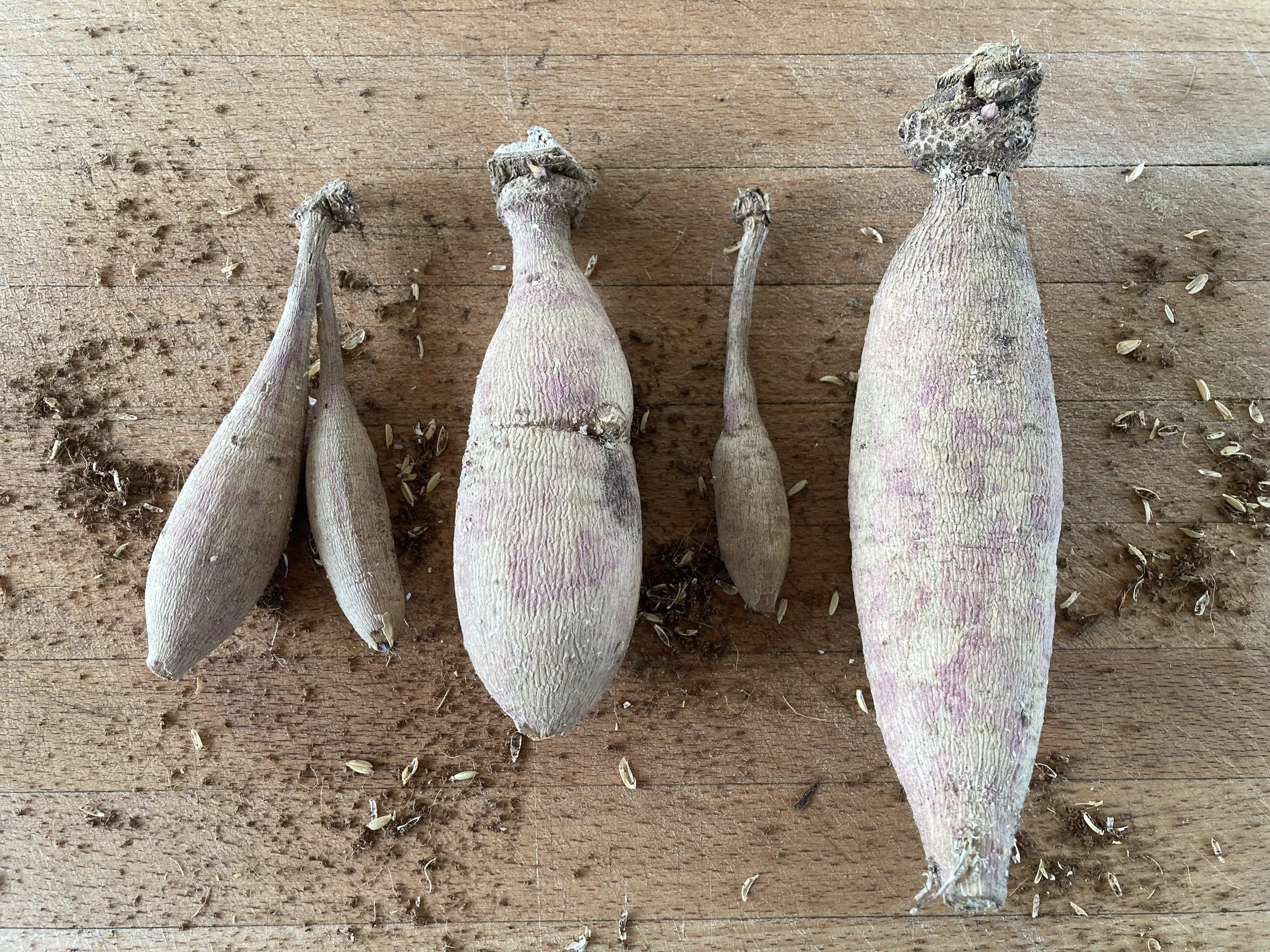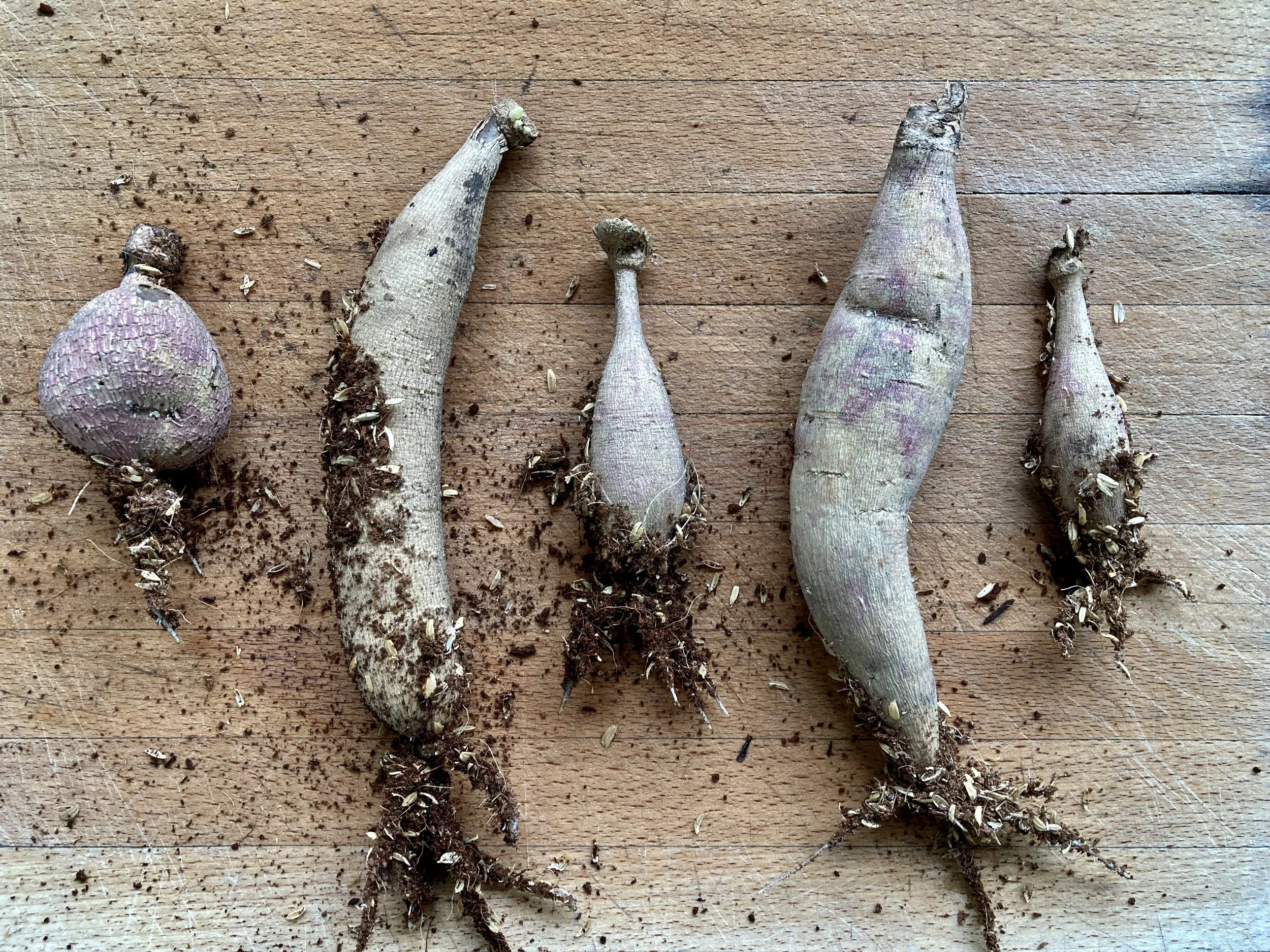Tuber Care, Planting, Growing and Harvest Information
Dahlias are a huge class of flowers that have a long history of breeders, experts and aficionados. Their textured blooms, with unusual petal shapes and stunning colours, are truly captivating! Their “show flower” trait may intimidate some but given full sun, good soil and consistent water (just like a tomato plant), they are easy to grow and thrive offering many, many blooms throughout the summer and early autumn.
Here are some general guidelines and how we treat dahlias here on our farm.
LATE WINTER/SPRING TUBER CARE
If you have received new tubers in mid Spring
Unpack & Inspect
Open your parcel right away.
TUBERS COME IN ALL SHAPES AND SIZES. WHEN JUDGING QUALITY, HEALTH OF THE TUBER AND A VIABLE EYE ARE THE KEY CHARACTERISTICS - NOT SIZE
Check each tuber.
A little dehydration is normal- this may feel shrivelled. This will still grow a vigorous plant.
A small amount of soil, dried roots, or minor surface blemishes is normal.
Look for “eyes” (tiny bumps or growth points) near the crown – this is where shoots will sprout. When looking for an eye, especially one that has not yet popped, look for something that is quite like a pimple. Eyes will be near the top of the tuber where it was once connected to the stalk. Tubers begin pushing their eyes, “waking up”, at different times, so the eyes may look different on each tuber. Once popped, they can be white, purple, light green or just a swelling as they try and push through the skin of the tuber. Especially the pompom varieties, the eyes are small. If you can't see the eye you can cover the tuber in potting mix (just slightly damp) and place it inside near a warm window. This can help the eye to swell and look more visible. If frost risk has passed for your climate you can plant the tuber out even if the eye hasn't 'popped'. All of our tubers are inspected by at least two different people who confidently saw an eye.
Tubers naturally send out fine white roots when they “wake up.” The eye will usually swell and pop after the roots start developing.
If a shoot has broken off, DO NOT WORRY! Your tuber will grow more!! It treats the broken shoot as an injury and attempts to compensate by sprouting multiple new shoots around the site of the damage.
Label the tubers - we stamp the tubers with our farm stamp but do not have stamps for each variety. We have ensured they are packed into labelled bags. You can choose to write on the tuber using an ink that resist UV and weather better - we suggest a Sharpie or Artline permanent markers. We also use plastic tags and No2 pencils which withstand a whole season of weather in the field. You can place the tag in with the tuber - and have a label on the box or bag. We rely on two forms of labelling.
VIABLE TUBERS All FROM ONE VARIETY - TUBERS COME IN ALL SHAPES AND SIZES. WHEN JUDGING QUALITY, HEALTH OF the TUBER AND a viable EYE ARE THE KEY CHARACTERISTICS - NOT SIZE
Storage (If Not Planting Immediately)
In Australia, most tubers are posted out in early spring, often before it’s warm enough to plant in the southern states.
Store tubers in a cool, dry location with airflow until planting time, out of direct sun, heat or freezing temperatures.
Ideal: a plastic crate, cardboard box or paper bag with peat moss, rice hulls, potting soil or a combination- we suggest finding what works for you. We use peat moss in plastic crates. Mist the medium slightly- it should not be WET but should feel cool. If your tubers arrived in peat moss, just check that it is lightly moist after its journey. This keeps the tubers humid and plump - from drying out too much. We actually just use a mister and mist straight into the bags - tubers and medium. It doesn’t take much to rehydrate the peat moss. Again, you are aiming for moist (cool to touch) NOT wet and squeezable. Use potting soil to top up the medium if that is what you have on hand. The aim is to keep the tuber nestled into a moist medium.
Do not over wet the medium or the tubers will rot.
You are not trying to water the tuber - just moisten the medium.
Do not store them in sealed plastic bags (they can rot).
Protecting your tubers from rodents and critters. If you think you have visitors in your tuber storage area, use a sealed box and monitor the moisture content (to ensure it is not too moist). Rats will chew through cardboard.
Pre-Sprouting (Optional but Helpful) - If you are concerned that your tuber does not have an eye, DO THIS
About 2–4 weeks before planting, you can “wake up” tubers by placing them in a pot or shallow tray with damp (not wet) potting mix and/or peat moss in a warm, bright, frost-free spot (but not in hot sun) and give it time. Place them in at a 45° with the crown above the soil line. We find just a move from 7°C to 15°C - and from dark to filtered light is enough to make the eyes swell.
Sometimes the eye is hidden under a bit of skin or takes longer to break dormancy.
Moisture balance matters: Make sure the medium is just slightly damp, not wet — too much moisture at this stage can lead to rot.
White roots without a visible eye just mean the plant is on its way, but not quite showing above-ground growth yet.
Pre sprouting gives your tubers a head start.
Dahlias, like other sun lovers, require 10-14 hours of light so as to not become leggy
PLANTING AND GROWING
TIMING
Dahlia’s are cold sensitive. Wait to plant your tubers until the ground is at least 15°C and all danger of frost has past. If your nighttime temperatures are consistently above 15°C, that is a great indicator that your tuber will be happy in the ground.
In the case of an unseasonably late frost, tubers generally take 2-6 weeks to break the surface - so that is your buffer!
If you are still unsure when to plant, plant when you would transplant a tomato plant. And if that still does not help, ask a local gardening friend when they plant their dahlias. The truth is that every growing area creates its own micro climate - so try your best and keep notes on what you might change for the next season!
In Southern Victoria, a safe bet is to plant them after Cup weekend AND we have successfully planted in early December and still been harvesting in mid-late April.
SITE
Dahlias’s require full sun - at least 6-8 hours a day. They also benefit from late afternoon shading in areas with intense summer heat. They do not grow well when they are too hot.
Choose a position with free draining, ph neutral soil. Again, if you treat your dahlia’s like tomatoes, they need similar soil.
We begin preparing the soil in the Autumn before our spring planting with compost, well rotted manure, rock phosphate and/or bone meal depending on the soil needs - we use a soil test to assess this. We then sow a diverse green manure mix of oats, peas, lupin, vetch, clover, rye. This not only protects the soil from heavy winter rains (if we have them) it also feeds the biology of our soil which in turn feeds our plants. We leave this to grow late autumn - early spring, mowing it down and incorporating it into the soil 3-4 weeks ahead of planting our dahlia tubers.
PLANTING
Dig a hole 10-15cm deep and place the tuber on its side horizontally with the growing eye facing up. Cover with soil.
WATER
Your soil should be evenly moist at planting. Wait to water until you see the shoot. Overwatering before you see the shoot can lead to tuber rot.
We have found dahlias respond well to consistent water throughout the growing season. They like their feet constantly moist and do not want to be soaking in water - a bog. We use drip irrigation to achieve this and set the timing throughout the season to achieve good even moisture at root depth. We lay out the drip irrigation at planting.
Protect shoots from snails and slug.
SPACING
Some dahlias are quite large plants. We allow 36-40cm between all varieties except the pompom’s which we plant at 20cm.
We prefer to plant 2 rows on our 75cm beds and we zig-zag the plants (do not plant the two rows opposite each other ). We also prefer wider aisles that can accomodate a cart for ease of picking.
PINCHING
When the shoot is about 20-30cm high, hard pinch the centre by cutting out about 10cm just above a leaf node. You should be able to see the branches forming. This encourages branching which increases flower production and stem length.
STAKING
With our farm’s proximity to the ocean, we can experience high Spring winds. We have found early staking protects young plants. That said, in our breeding project we are encouraging strong stems in hopes that with close planting, the plants will support each other. We are also cutting deep into the plants for harvest.
Corralling dahlias
We use 2.5m metal posts (pounded into the ground about 40cm) every 2.5m, a row either side of the plants. We string heavy bailing twine between each post- a new string at 20- 30cm intervals. We then just ensure that the plants are tucked into the twine on either side.
Home gardeners can secure plants to a single stake or use a metal cage system.
HARVEST AND VASE LIFE
Dahlia blooms do not keep opening after harvest. Ensure that blooms are near fully open AND check that the petals on the back side of the flower are still fresh. If they are brown, wilted and/or falling off, your vase life will be effected as the bloom is already old.
Dahlia’s are considered “event” flowers. Expect a vase life of 5-7 days with flowers cut in the coolest part of the day and placed immediately into cold water. We have great vase life results with the following three recommendations:
1) Ensure plants have been watered at least 12 hours prior to cutting.
2) Harvest in the cool part of the day and instantly hydrate the flowers.
3) Transfer to a cool shed or room.
Change the water in your container daily and/or use commercial floral preservative to keep bacteria at bay. Miniature Ball and Ball bloom types may have a longer vase life.
Flowers that will be travel benefit from one or several of the following recommendations: Transferring into buckets with 25%-50% floral preservative; Sear stem ends by placing into 70-80°C (just off boiling) water and allow to sit in water and cool for one hour; Chill for at least 8 hours at 3-4°C.
DEADHEADING
Flowers permitted to form seed shift the plants energy into seed production. This can reduce further blooms and rob energy from tuber production. Consequently we remove all blooms damaged or past their prime consistently once or twice a week.
NOTE - For more detailed information about BLOOM TYPE, please read this.
STORING DAHLIA TUBERS
To dig or not to dig - It is a question for those in mild winter areas (winters that rarely fall below 5°C) and one we cannot answer for you. If your winter is wet and/or your ground freezes in winter, lifting your tubers protects them. Talk to other dahlia growers in your area.
We offer the following guidelines for winter storage of dahlia tubers.
Store your tubers in a rodent proof area or rodent proof boxes. Mice and Rats can destroy your entire collection quickly!
Store in a space that maintains a temperature around 5-10C°, away from direct light.
Store tubers in peat moss, soil mix and/or vermiculite to protect from moisture - It is a balancing act. You want your tubers to remain plump and not dry and shrivel. AND you want to protect your tubers from cold and rot. If this is all new, we suggest not just putting them in a dark corner and hoping for the best. Check on them throughout winter and see if your storage method and place of storage is working
Store in a space with adequate airflow to ensure condensation is not forming.
The ideal is 7 °C with 85% humidity and stable - a root cellar that maintains a constant temperature is preferred to a space that fluctuates.
View Transition Farm Dahlia Tuber Collection
Additional Resources:
There are many online resources available.
The Dahlia Society of Victoria has a comprehensive website and joining the society may offer you a great collective of growers and further learning opportunities.
We LOVE books …
Possibly more detailed then many like, we adore
DAHLIAS Seed to Bloom by Kristine Albrecht
Dahlias in Australia – The Winkie Way and was written by the late John Menzel of Winkie Dahlias is out of print but look in used book stores in case you can find this gem.
Many of the US publications include photos of varieties unavailable in Australia. That is the case with Kristine Albrecht’s book BUT she has interviewed world wide growers, as did the late John Menzel, offering many different perspectives on cultivation.












